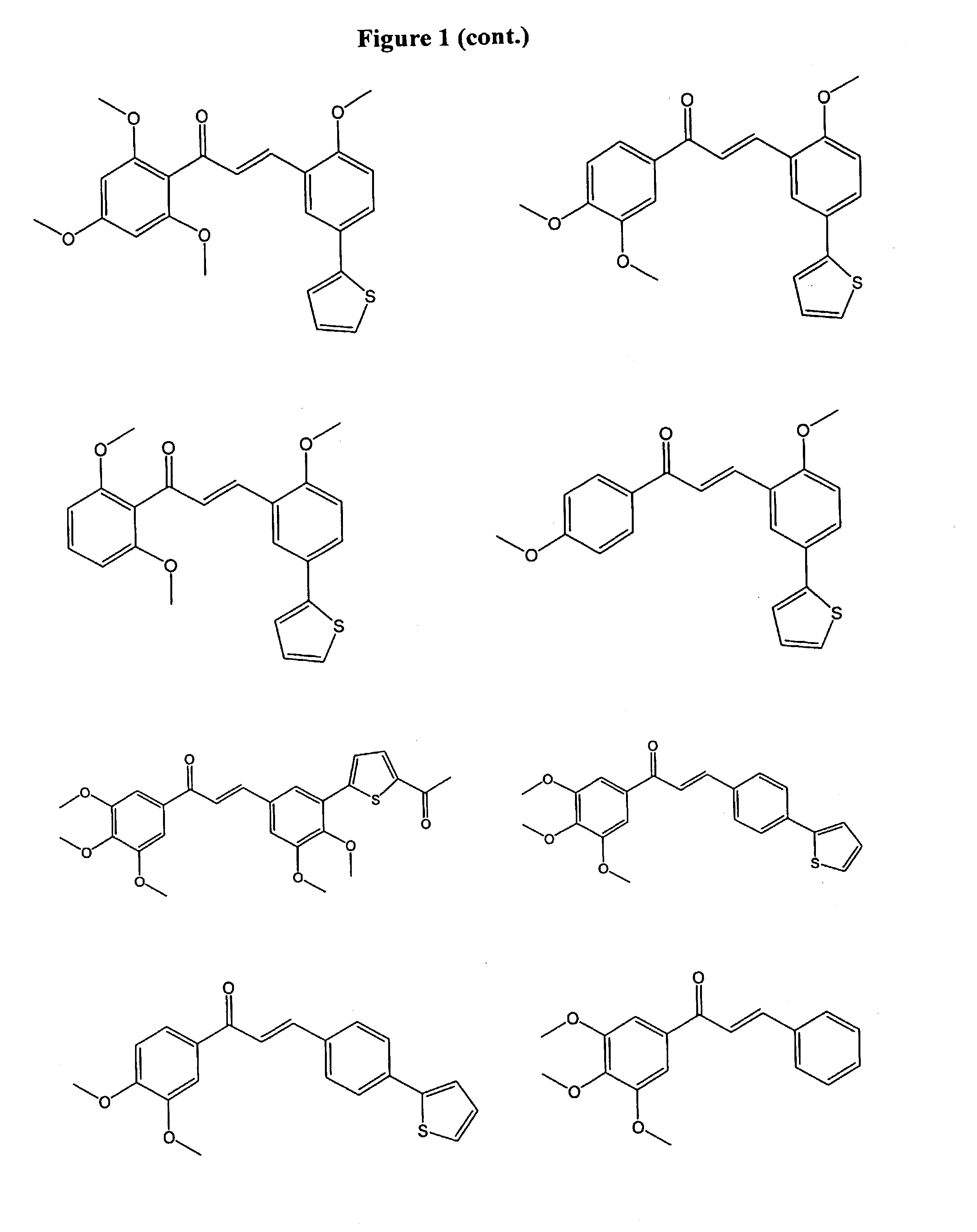1,3-bis-(substituted-phenyl)-2-propen-1-ones and their use to treat VCAM-1 mediated disorders
a technology of substituting phenyl and propen-1, which is applied in the field of 1, 3bis(substitutedphenyl)2propen-1ones and their use to treat vcam-1 mediated disorders, can solve the problems of thrombosis, myocardial infarction and ischemic heart disease, late graft loss, and plaque rupture, so as to inhibit the progression of atherosclerosis and treat or prevent.
- Summary
- Abstract
- Description
- Claims
- Application Information
AI Technical Summary
Benefits of technology
Problems solved by technology
Method used
Image
Examples
example 1
[0477]
[0478]Ex-1A: 3′,4′,5′-Trimethoxyacetophenone (1.47 g, 6.9 mmol) and 3-bromo-4,5-dimethoxybenzaldehyde (1.64 g, 0.67 mmol) were suspended in ethanol (50 mL). Sodium hydroxide solution (50%, 1 mL) was added dropwise. The mixture was stirred at room temperature for 2 h. Water (20 mL) was added. The precipitate was filtered out, washed with water and dried over an oil pump to give 1.91 g (65%) of the desired product, 3-(3-bromo-4,5-dimethoxyphenyl)-1-(3,4,5-trimethoxyphenyl)-2-propen-1-one, as a slightly yellow residue.
[0479]3-(3-Bromo-4,5-dimethoxyphenyl)-1-(3,4,5-trimethoxyphenyl)-2-propen-1-one (0.105 g, 0.2 mmol) from Ex-1A was dissolved in ethylene glycol dimethyl ether (20 mL). Tetrakis(triphenylphosphine)palladium(0) (0.116 g, 0.1 mmol) was added, and the mixture was stirred at room temperature under nitrogen for 5 min. 2-Thiopheneboronic acid (0.128 g) and sodium carbonate solution (2 M, 0.5 mL) were added. The mixture was stirred at reflux under nitrogen overnight. Upon c...
example 6
[0483]
[0484]Ex-6A: 5-Bromo-2,4-dimethoxybenzaldehyde (4.9 g, 20.0 mmol) was dissolved in ethylene glycol dimethyl ether (50 mL). Tetrakis(triphenylphosphine)palladium(0) (2.32 g, 2 mmol) was added, and the mixture was stirred at room temperature under nitrogen for 5 min. Benzo[b]thiophene-2-boronic acid (4.27 g, 24 mmol) and sodium carbonate solution (2 M, 20 mL) were added. The mixture was stirred at reflux under nitrogen for 24 hours. Upon cooling to room temperature, it was poured into water and extracted with ethyl acetate. The organic phase was dried over sodium sulfate and evaporated. Silica gel chromatography (hexane / ethyl acetate 2:1 then 1:1) gave 4.75 g (83%) of the desired 5-(benzo[b]thien-2-yl)-2,4-dimethoxybenzaldehyde.
[0485]3′,4′,5′-Trimethoxyacetophenone (1.62 g, 7.7 mmol) was dissolved in ethanol (50 mL). Sodium hydroxide solution (50%, 4 mL) was added and the mixture was stirred at room temperature for 30 minutes. 5-(Benzo[b]thien-2-yl)-2,4-dimethoxybenzaldehyde (2....
example 56
[0490]
[0491]To a suspension of 2-methoxy-5-(thien-2-yl)benzaldehyde (0.5 g, 2.3 mmol), obtained in the same manner as described in Ex-6A, in 5 N KOH solution was added cetyltrimethyl-ammonium chloride (CTACl, 25% in water, 4 mL, 3.0 mmol) followed by the addition of 4′-hydroxy-3′-methoxyacetophenone (0.38 g, 2.3 mmol). The mixture was stirred at room temperature overnight. Then it was acidified to about pH 1 with 6 M sulfuric acid, saturated with sodium chloride, and extracted with dichloromethane. The organic phase was washed with brine, dried and evaporated. Silica gel chromatography (hexane / ethyl acetate, 3:1 then 1:1) gave 0.61 g (73%) of a foam as the desired 3-[2-methoxy-5-(thien-2-yl)phenyl]-1-(4-hydroxy-3-methoxyphenyl)-2-propen-1-one product, m.p. 142-144° C. 1H-NMR (300 MHz, CDCl3): 8.21 (d, 1H), 7.82 (s, 1H), 7.55-7.75 (m, 4H), 6.85-7.15 (m, 4H), 6.14 (s, 1H), 4.00 (s, 3H), 3.95 (s, 3H).
PUM
| Property | Measurement | Unit |
|---|---|---|
| temperatures | aaaaa | aaaaa |
| time | aaaaa | aaaaa |
| temperature | aaaaa | aaaaa |
Abstract
Description
Claims
Application Information
 Login to View More
Login to View More - R&D
- Intellectual Property
- Life Sciences
- Materials
- Tech Scout
- Unparalleled Data Quality
- Higher Quality Content
- 60% Fewer Hallucinations
Browse by: Latest US Patents, China's latest patents, Technical Efficacy Thesaurus, Application Domain, Technology Topic, Popular Technical Reports.
© 2025 PatSnap. All rights reserved.Legal|Privacy policy|Modern Slavery Act Transparency Statement|Sitemap|About US| Contact US: help@patsnap.com



